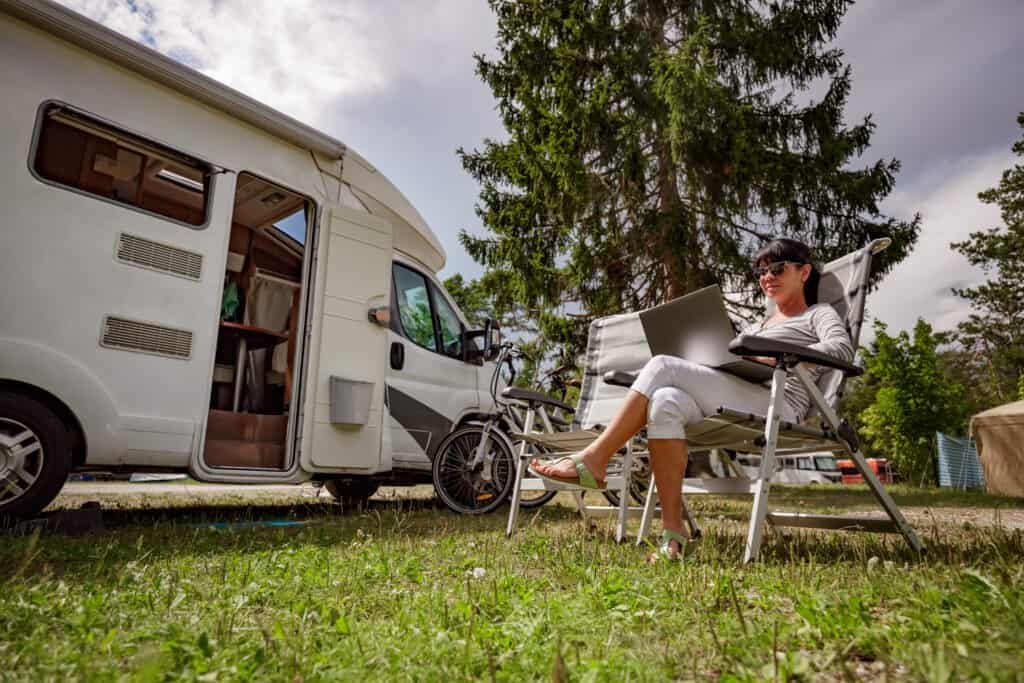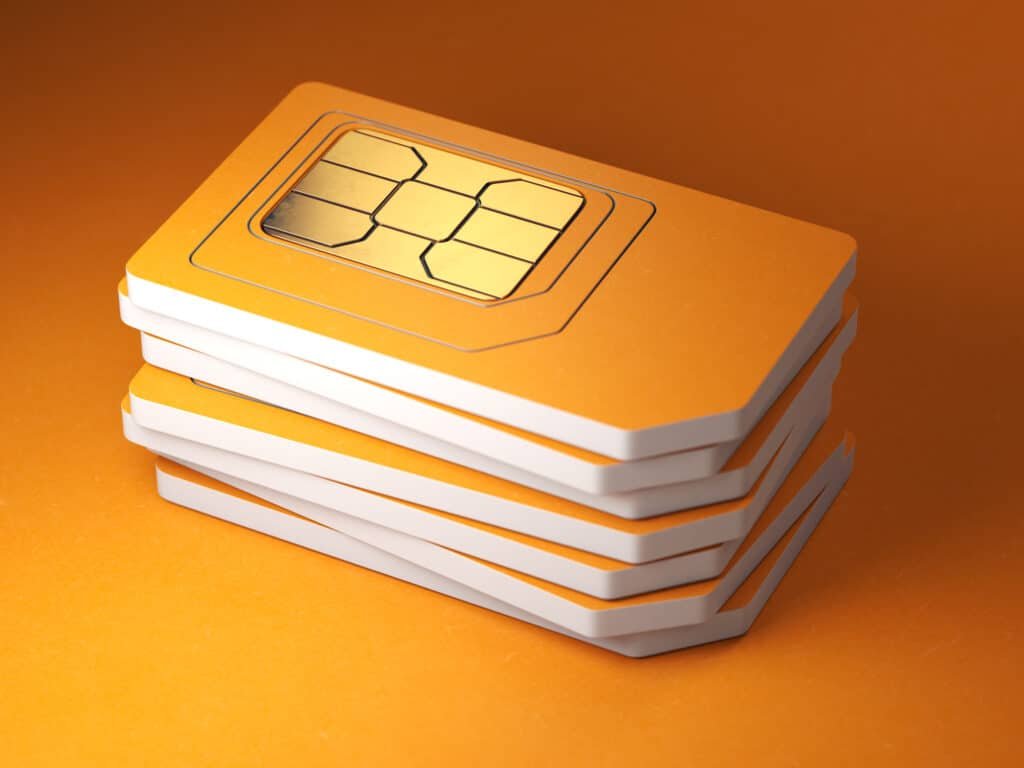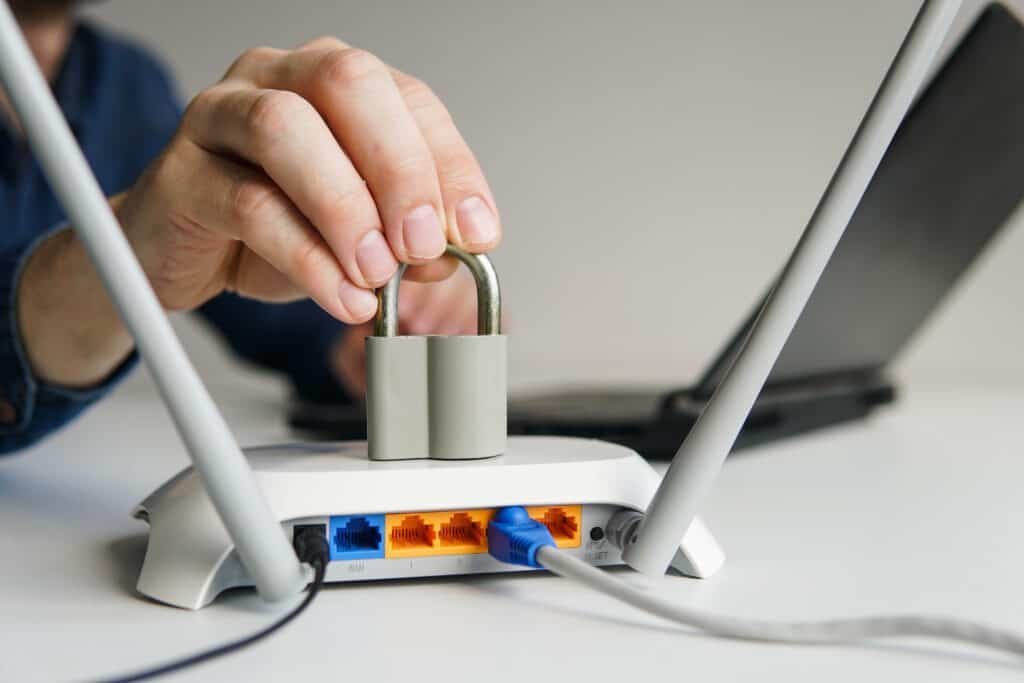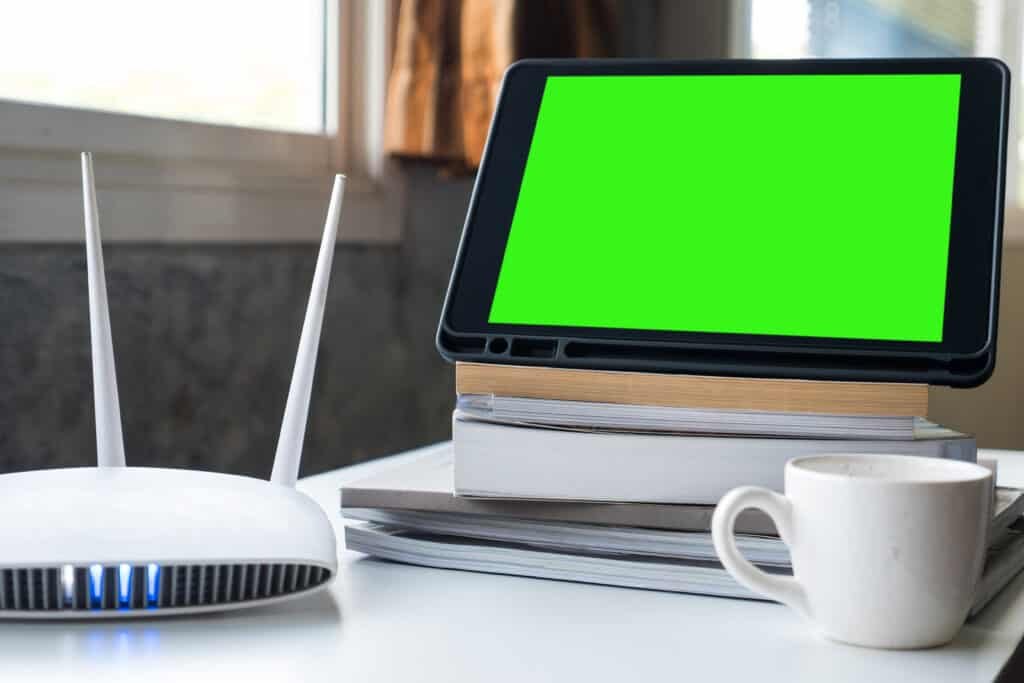Get Connected On The Road: How to Connect WiFi in Motorhomes (2024 Update)

We may earn a small fee from the companies mentioned in this post.
Imagine the freedom of traveling in a motorhome, exploring breath-taking landscapes, and experiencing new cultures – all while staying connected to the digital world. But how do you ensure a reliable and secure internet connection on the road?
Fear not, as we have compiled the ultimate guide to finding and optimising WiFi in motorhomes. We’ll cover a wide range of topics, from understanding various motorhome WiFi options to securing your connection and troubleshooting common issues. Get ready to embark on your motorhome adventure with confidence, knowing you’ll stay connected every step of the way.
Short Summary – How to Connect WiFi in Motorhomes
Evaluate pros and cons of motorhome WiFi options to determine best solution.
Enhance signal strength through proper positioning, external antennas, and WiFi boosters.
Manage data usage & secure connection for seamless experience while traveling abroad.
Understanding Motorhome WiFi Options

A motorhome offers the perfect opportunity to escape the daily grind and embark on an adventure. However, staying connected to the internet is vital for many of us, whether it’s for work, staying in touch with loved ones, or simply enjoying some entertainment on the go.
There are three primary options for acquiring a reliable internet connection in a motorhome: mobile data connection, connecting to existing wifi networks, and using dedicated motorhome wifi devices. Each option has its pros and cons, and your choice will depend on your specific needs and preferences.
Utilizing the 4G mobile network with a data sim is recommended for obtaining an Internet connection in caravans and motorhomes. A popular and cost-effective solution is to use your mobile network provider or phone’s tethering capabilities to act as a WiFi hotspot, providing internet access in a motorhome for multiple devices. However, for a more reliable 4g signal shared among multiple devices, a MiFi device is the best mobile WiFi hotspot option.
Alternatively, you can either connect multiple devices to existing WiFi networks or use campervan WiFi dongles and routers, such as the Huawei E5577 or the Netgear Nighthawk. Ultimately, the most suitable method for you will depend on your data usage, budget, and the level of internet connectivity you require.
Lean how to protect yourself from Vinted scams, read our informative article and stay stafe online.
Mobile Data Connection
Mobile data connection offers a reliable and cost-effective option for campervan WiFi. By utilizing a data sim card and a 4G router with an antenna or mobile device, you can establish a connection to the 4G network in your motorhome. A significant advantage of using a mobile data connection is that it is not subject to sharing with other campers, as is the case with campsite WiFi routers, thus avoiding potential drops in speed during peak usage times.
However, there are some drawbacks to using a mobile data connection in a motorhome, such as the cost of data, the difficulty of setting up each time, power consumption, weak signal, and unreliability, especially when in a campervan. It is crucial to research the best deals available and be mindful of roaming charges when traveling in Europe, with 3 and Vodafone being the recommended options.
Additionally, always verify if any contract services restrict the amount of data that can be utilized when tethering or using a mobile hotspot or device.
Connecting to Existing WiFi Networks
Another option to acquire internet access in your motorhome is connecting to existing WiFi networks. This can be done using WiFi booster devices, such as the Kuma WiFi kit or the Huawei E5577C, which offer a high-powered, long-range directional antenna mounted on the exterior of the vehicle and a WiFi repeater installed within the campervan that rebroadcasts the signal wirelessly to devices.
These devices can help extend the range and improve the signal strength of on-site WiFi when positioned outside of a caravan or motorhome. However, it is essential to note that a WiFi booster may not always enhance your connection, depending on the cause of the weak signal.
If the your phone signal strengthens when you approach the campsite’s WiFi antenna, then a WiFi dongle booster should be beneficial. It is also crucial to position the dongle in the skylight or near a window in areas of low signal for campervan WiFi.
Dedicated Motorhome WiFi Devices

Dedicated motorhome WiFi devices are antennas or small boxes that are affixed to the roof of a motorhome or campervan to amplify any WiFi signal that is received. These devices offer versatility, as they can be powered by either 12v or 240v, making them ideal for mobile WiFi when wild camping or on campsites. Moreover, they can boost weaker WiFi signals, and provide internet access in areas where there was previously none, enabling you to stream TV over a poor connection and gain internet access during your travels.
There are some drawbacks to using dedicated motorhome WiFi devices, such as their bulkier size compared to a MiFi, increased power consumption, lack of mobility, and higher cost. Nevertheless, these devices can be a valuable addition to your motorhome internet setup if you require a more reliable and robust connection.
Enhancing Your Motorhome WiFi Signal

Once you have selected your preferred method of acquiring internet access in your motorhome, it is crucial to optimise your motorhome WiFi router signal strength. There are several strategies you can employ to enhance your motorhome WiFi signal, such as positioning devices for maximum signal, utilising external antennas for best signal, and selecting an appropriate WiFi booster.
Let’s dive into these methods to ensure you get the best possible internet connection during your motorhome adventures.
Positioning Devices for Optimal Signal
Proper positioning of your phone, MiFi device, or router can significantly impact the signal strength and speed of your internet connection. To ensure optimal signal, place the wireless router in a central location, elevated from the floor, with the antennas oriented vertically. Additionally, try to position the router away from other electronic devices, such as microwaves, cordless phones, and baby monitors, which can cause interference.
Moreover, in areas of low signal for campervan WiFi, it is recommended to position the campervan WiFi dongle either in the skylight or near a window. By following these positioning tips, you can significantly improve your motorhome WiFi signal and enjoy a better internet experience.
Using External Antennas
External antennas can be a valuable addition to your motorhome WiFi setup, as they amplify the signal from outside the vehicle and transmit it to the router through a cable. There are two main types of antennas: omni-directional and directional. Omni-directional antennas can receive a signal from all directions (360 degrees) and enhance the signal strength by capturing the signal reflected off the campervan’s bodywork and other nearby objects.
Directional antennas, on the other hand, offer a more robust signal but have a limited angle of coverage, typically around 30 degrees. It is essential to consider your specific needs and the environment you will be traveling in when selecting an external antenna.
For instance, a directional antenna will operate most effectively when there is an unobstructed line of sight to the mast. Understanding the advantages and drawbacks of different antenna types will help you make an informed decision and optimize your motorhome WiFi signal.
Selecting the Right WiFi Booster
A WiFi booster is a device that enhances the signal of a WiFi network, providing improved coverage and faster speeds. When deciding on a WiFi booster for your motorhome, it is essential to consider factors such as the size of the motorhome, the number of devices that will be connected, the type of signal available, the cost of the device, the installation process, and the customer support provided.
One popular and well-established solution for motorhomes in the UK and Europe is the iBoost system, which offers a range of features to enhance your motorhome WiFi signal. By carefully evaluating your specific needs and considering the factors mentioned above, you can select the right motorhome WiFi booster to optimize your motorhome WiFi signal and ensure a smooth internet experience during your travels.
Managing Data Usage in Motorhomes

As you enjoy your motorhome adventures, it’s essential to manage your data usage effectively to avoid running out of data or incurring additional charges.
In this section, we’ll discuss strategies for estimating data needs, reducing data consumption, and monitoring data usage, so you can make the most of your motorhome WiFi experience without any unexpected surprises.
Estimating Data Needs
To accurately estimate your data needs for internet usage during your motorhome journeys, it’s helpful to calculate the amount of data consumed per activity and multiply it by the frequency of the activity. For example, when streaming videos, one hour of video streaming may consume approximately 1-2GB of data.
By understanding your typical usage patterns and considering the number of people traveling with you, you can estimate your overall data requirements. There are also online data calculators available that can assist you in estimating your data requirements.
Additionally, many internet service providers offer data usage monitoring tools to help you track your data usage. By estimating your data needs accurately, you can ensure that you have an adequate data plan for your motorhome adventures.
Reducing Data Consumption
Minimising data usage is crucial to avoid running out of data or incurring additional charges during your motorhome travels. Some effective strategies for reducing data consumption include utilizing Wi-Fi when available, disabling automatic app updates, restricting background app refresh, and limiting the usage of apps that consume the most data.
To make the most of Wi-Fi, be sure to detect any available networks in the vicinity and establish a connection. If no networks are available, you may use your mobile data connection. Additionally, you can disable automatic app updates and background app refresh in your device’s settings to prevent apps from downloading data-intensive updates and consuming data in the background.
By implementing these strategies, you can effectively reduce data consumption and optimize your motorhome WiFi experience.
Monitoring Data Usage
Keeping track of your data usage is vital to ensure you stay within your data allowance and avoid unexpected charges. Many internet service providers offer data usage monitoring tools to help you track your data usage. Additionally, several applications, such as GlassWire Data Usage Monitor, Data Usage Monitor, and My Data Manager, are available for monitoring data usage on your device. These applications can help track data usage and even restrict individual apps from utilizing unlimited data on.
Monitoring data usage on an iPhone is also straightforward. You can view app data usage by navigating to Settings > Mobile Data or Settings > Cellular. By regularly monitoring your data usage, you can make informed decisions about your mobile internet activities and manage your data allowance effectively during your motorhome journeys.
Choosing the Best SIM Card for Motorhome WiFi

Selecting the right SIM card for your motorhome WiFi is crucial to ensure a reliable and cost-effective internet connection during your travels. When choosing the best SIM card, it’s essential to compare network coverage, evaluate data plans, and consider international data roaming fees and aspects.
In this section, we’ll provide guidance for making an informed decision, so you can stay connected and enjoy a seamless motorhome WiFi experience.
Comparing Network Coverage
Network coverage is a critical factor to consider when selecting the right SIM card for your motorhome WiFi. Different network providers may offer varying levels of coverage, connection speeds, and signal strength, depending on your location. It’s essential to research and compare the coverage offered by various providers in the areas you plan to travel to ensure that you have a reliable and consistent internet connection.
You can check network coverage maps provided by network providers or use speed test tools to determine the strength and reliability of the signal in a specific area. By comparing network coverage among different providers and speed test them, you can make an informed decision and choose the best SIM card for your motorhome WiFi needs.
Evaluating Data Plans
When selecting a SIM card for your motorhome WiFi, it’s crucial to evaluate the data plans offered by various providers. Factors to consider include the amount of data provided, the connection speed, the coverage area, and the cost of the plan. Comparing different plans from multiple providers will help you determine the most advantageous option for your motorhome WiFi needs.
It’s also essential to review the fine print of any prepaid data SIM cards to determine the validity period of the data once activated. This will help you avoid any unexpected charges or loss of data due to expiration during your travels.
International Roaming Considerations
International roaming is an important factor to consider when selecting a SIM card for motorhome wifi, as the costs associated with using a mobile phone abroad without the right plan can be substantial. When traveling in a motorhome, you can take advantage of your existing mobile plan, opt for a new contract, or utilise a dedicated motorhome WiFi device, depending on your requirements and preferences.
It’s essential to research the roaming charges and data limits imposed by various providers how much data is, especially when traveling in Europe, as additional fees have been reintroduced for unlimited roaming, and data limits have been imposed on EU roaming, even with unlimited data plans, following Brexit.
By considering international data roaming and aspects and selecting the right local SIM card or plan, you can stay connected and enjoy a hassle-free motorhome WiFi experience during your travels.
Securing Your Motorhome WiFi Connection

A secure motorhome WiFi connection is essential to protect your data and online identity from potential malicious actors. In this section, we’ll discuss steps for securing your motorhome WiFi connection, such as setting up a secure WiFi network and using VPNs for added security.
Check out our informative blog on the best motorhome SatNav
Protecting Your Motorhome WiFi Router and Securing Wireless Access
Securing your motorhome WiFi router and wireless access is crucial to protect your personal information and prevent unauthorised access. Here are some steps you can take to enhance the security of your motorhome WiFi:
1. Change Default Login Credentials
The first step in securing your WiFi router is changing the default username and password. These default credentials are often easy to guess or can be found online, making your network vulnerable to unauthorised access. Create a strong, unique password and avoid using personal information that could be easily guessed.
2. Enable Network Encryption
Most WiFi routers offer several types of network encryption, such as WEP, WPA, and WPA2. Of these, WPA2 is currently the most secure. Enabling network encryption will prevent unauthorized devices from connecting to your network and will encrypt your data, making it unreadable to anyone who might intercept it.
3. Change Your Routers Name
To set up a secure WiFi network in your motorhome, it’s crucial to change the default name and password of your WiFi router, and enable network encryption. When selecting a unique name for your WiFi network, avoid using personal information such as your name, address, or phone number.
4. Regularly Update Your Router’s Firmware
Manufacturers regularly release firmware updates for their routers to fix bugs, add new features, and improve security. Make sure to regularly check for and install these updates to ensure your router is as secure as possible.
5. Disable Remote Management
Some routers allow you to manage their settings remotely. While this can be convenient, it can also be a security risk. If you don’t need this feature, it’s best to disable it to prevent unauthorized access.
6. Use a VPN
A Virtual Private Network (VPN) encrypts your internet connection, making it much more difficult for anyone to intercept and read your data. Using a VPN can add an extra layer of security, especially when you’re using public WiFi networks.
7. Set Up a Guest Network
If you often have guests who want to use your WiFi, consider setting up a guest network. This will allow your guests to connect to the internet without giving them access to your main network and any connected devices.
8. Disable WiFi When Not in Use
When you’re not using your WiFi, such as when you’re driving or sleeping, consider turning it off. This will not only save power but also reduce the opportunity for unauthorized access.

By following these steps, you can significantly improve the security of your motorhome WiFi and protect your personal information. Remember, the key to good security is regular maintenance and vigilance
Using VPNs for Added Security
VPNs (Virtual Private Networks) offer an additional layer of security for motorhome wifi users. They create an encrypted tunnel to keep your data safe. Masking your IP address, they protect your online identity as well as enable you to securely access public Wi-Fi hotspots.
VPNs can be particularly useful for motorhome WiFi if you wish to work securely online or watch UK television outside the country. There are various VPN providers available, such as ExpressVPN, NordVPN, and SurfShark. These providers offer robust encryption and are compatible with mobile devices.
Setting up a VPN for motorhome WiFi is a straightforward process, involving creating an account with a VPN provider, downloading and installing the VPN software on your device, and connecting to the VPN. By using a VPN, you can enhance the security of your motorhome WiFi connection and browse the internet with confidence.
Read our article on Protecting your home from Cybercriminals
Troubleshooting Common Motorhome WiFi Issues
Even with the best motorhome WiFi setup, you may occasionally encounter issues with your motorhome internet and connection. In this section, we’ll discuss troubleshooting common motorhome WiFi issues, such as diagnosing connectivity problems, improving slow speeds, and resolving device compatibility issues.
By following these guidelines, you can quickly identify and address any issues, ensuring a smooth and enjoyable motorhome WiFi experience.
Diagnosing Connectivity Problems

When faced with connectivity issues, it’s essential to assess the signal strength of the WiFi network, review the router settings, and ensure the device is compatible with the network. Power cycling, which involves powering off and powering on all devices and equipment connected to the network, can help reset the network and diagnose any connectivity issues.
In addition, inspect physical network connections for any loose cables, incorrect settings, or other potential issues that may be causing connectivity problems. To further diagnose connectivity issues, you can use network troubleshooting tools such as Ping, Traceroute, Ipconfig/Ifconfig, and NSlookup.
By following these steps, you can effectively identify and address any connectivity problems, ensuring a reliable motorhome WiFi connection.
Improving Slow Speeds
Slow internet and upload speeds can be frustrating, but there are several methods to enhance the speed of your motorhome WiFi connection. A WiFi booster or antenna can potentially be an effective solution for increasing upload speed in a motorhome, as it can extend the range of the existing wireless signal, amplifying it and delivering it to new areas within the motorhome, resulting in doubled coverage area and upload speed.
Directional antennas, such as the Kuma WiFi kit or the Huawei E5577C, can offer a more robust signal but have a limited angle of coverage, typically around 30 degrees. It’s essential to consider your specific needs and the environment you will be traveling in when selecting an external antenna. For instance, a directional antenna will operate most effectively when there is an unobstructed line of sight to the mast.
By understanding the advantages and drawbacks of different antenna types and implementing additional, reliable signal-enhancing methods, such as using signal repeaters or mesh networks, you can improve slow speeds and enjoy a better internet experience in your motorhome.
Resolving Device Compatibility Issues
Device compatibility issues can cause connectivity problems and slow internet speeds in your motorhome. To resolve these issues, it’s essential to update software or drivers, clear cache and data, reinstall the app, and adjust hardware settings as needed. Additionally, you may try installing an earlier version of the app or utilizing a third-party app store.
To update software or drivers, download the most recent version from the manufacturer’s website or utilize a third-party software updater. Clear cache and data by navigating to the app’s settings and selecting the “Clear Cache” and “Clear Data” options. By following these steps, you can effectively resolve device compatibility issues and ensure a smooth and enjoyable motorhome WiFi experience.
Best Mobile WiFi for Motorhomes
When it comes to staying connected on the road, choosing the right mobile WiFi for your motorhome is crucial. There are several options available, each with its own set of features and benefits. Here are some of the best mobile WiFi solutions for motorhomes:
- WiFiRanger: Known for their mobile WiFi and LTE solutions, WiFiRanger offers a range of products designed specifically for RVs, buses, and boats. Their devices provide robust connectivity, ensuring you can stay connected even while traveling.
- Winegard ConnecT 2.0 4G2: This device from Winegard is designed to keep you connected with friends and family on the road. It offers reliable, uninterrupted connectivity, making it a great choice for motorhome owners.
- Winegard Gateway 5G: Another excellent product from Winegard, the Gateway 5G allows you to easily create a connectivity hub for your motorhome. It’s designed to keep you connected with friends and family, no matter where your travels take you.
Summary
In conclusion, staying connected while traveling in a motorhome is both achievable and essential for many modern adventurers.
By understanding various motorhome WiFi options, optimising your WiFi signal, managing data usage, choosing the right SIM card, securing your connection, and troubleshooting common issues, you can ensure a seamless and enjoyable motorhome WiFi experience.
So pack your bags, hit the open road, and stay connected with confidence, knowing that with the right tools and strategies, you’ll never miss a beat in the digital world.
Frequently Asked Questions
How do you get WiFi in a motorhome?
For motorhome owners looking to get WiFi on the road, the best solution is to get a dongle or router specifically designed for use in motorhomes. Alternatively, you can also use your phone’s hotspot as an option or invest in a specialised motorhome WiFi system. With the right technology, you’ll be able to access the internet wherever your travels take you.
How do I get Internet in my motorhome UK?
A mobile internet connection can provide your motorhome with an internet signal. With a 3G or 4G signal, you can access a number of network providers to get a data-only SIM package. This data cap will give you up to 20 GB of data per month to use to browse the web and get internet back in your motorhome UK.
Do motorhomes come with WiFi?
Yes, motorhomes do come with free WiFi everywhere. While not all motorhomes are equipped with WiFi systems, there are several ways to bring WiFi into the vehicle.
These include installing a router/dongle, satellite broadband, getting a WiFi system designed for motorhomes, or using your phone’s hotspot. All of these options are effective and provide reliable Internet access for your trips.
Can you put WiFi in a camper van?
Yes, you can put WiFi and satellite internet in a campervan. To do so, you’ll need a WiFi dongle to connect your computer or device to the mobile internet anyway, as well as a mobile data plan to provide internet access.
With both of these in place, you’ll be able to enjoy a reliable WiFi connection on the road!
How does WiFi work in motorhome?
WiFi in a motorhome typically works by using a mobile hotspot device or a dedicated WiFi router that connects to the internet through cellular networks. These devices use a SIM card to access the internet and create a local WiFi network inside the motorhome, allowing you to connect your devices to the internet.
Can you get WiFi in a traveling RV?
Yes, you can get WiFi in a traveling RV by using a mobile hotspot device or by utilising campground WiFi if available.
What is the best WiFi for RV traveling?
The best WiFi option for RV traveling is to use a combination of cellular data plans from different providers, along with a mobile router or hotspot device that supports multiple SIM cards. This allows you to have a reliable internet connection while on the road, even in remote areas. Additionally, you can consider investing in a high-gain external antenna to boost the signal reception and improve the overall connectivity.
Useful external references
Here are some external website links that could be useful for the blog “WiFi in Motorhomes”:
- WiFiRanger: This company provides mobile WiFi and LTE solutions, perfect for those struggling with internet connectivity in their RV, bus, or boat while traveling. They offer a range of products and support to ensure you stay connected on your journey.
- Winegard: Winegard offers a variety of technology solutions for on-the-go lifestyles, including connectivity and TV products. They have a range of products like the ConnecT 2.0 4G2 and Gateway 5G that can help you stay connected with friends and family on the road. They also provide a variety of service plans to fit different needs.
With over three decades of experience in the heart of London’s financial sector, I have dedicated my career to the pursuit of robust cybersecurity practices and IT leadership. As a Certified Information Systems Security Professional (CISSP), Certified Information Security Manager (CISM), Certified Chief Information Security Officer (C|CISO), Certified Ethical Hacker (CEH), and Computer Hacking Forensic Investigator (CHFI), I bring a wealth of knowledge and expertise to the table.
My journey in the field of cybersecurity has not only been about personal growth but also about sharing my insights with others. As an international speaker, I have had the privilege of addressing audiences worldwide, discussing the importance of cybersecurity in today’s digital age. My passion for knowledge sharing extends to my work as an author and blogger, where I delve into the complexities of cybersecurity, offering practical advice and thought leadership.
In my role as a CISO and Head of IT, I have overseen the development and implementation of comprehensive information security and IT strategies. My focus has always been on creating resilient systems capable of withstanding the evolving landscape of cyber threats.
My Master’s degree in Cybersecurity has provided a solid academic foundation, which, when combined with my practical experience, allows me to approach cybersecurity from a holistic perspective.
I am always open to connecting with other professionals in the field, sharing knowledge, and exploring new opportunities. Let’s secure the digital world together.

